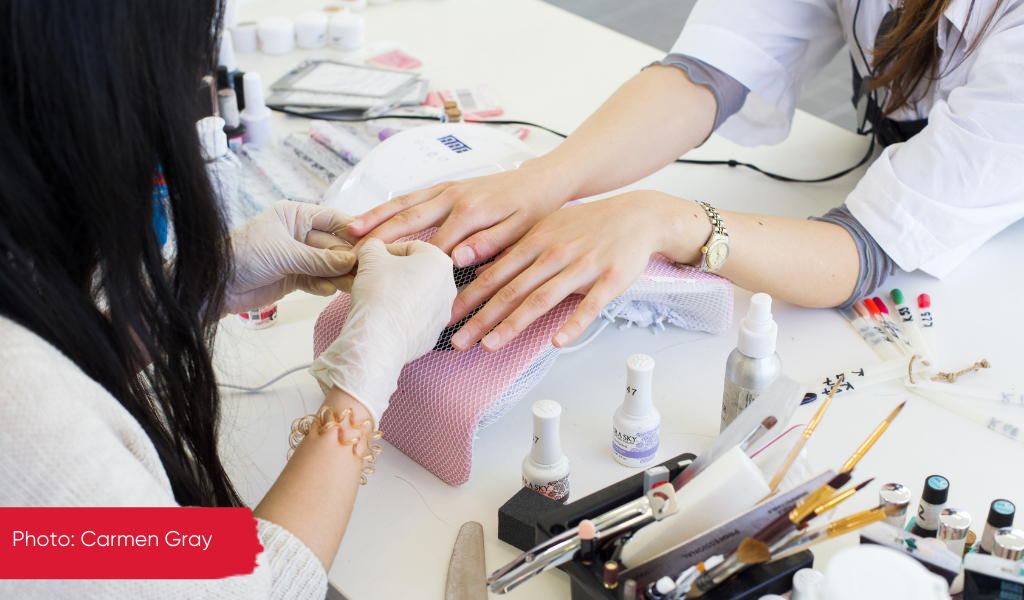The total amount of money international migrants send back home to support families – is over three times the amount of Official Development Assistance (ODA). But as legal migration routes are increasingly restricted, people find other ways to cross borders to find paid work in other countries. And some, such as the 39 Vietnamese found dead in a lorry container in Essex, have paid for their dream to work with their lives. The youngest was just 15. Many of them were on their way to the UK to work in nail salons.

Nails is an interactive art installation that explores the fraught dynamics of the beauty industry, race and migration. Together with Vietnamese nail-shop owners, stylists, activist researchers and a Korean visual artist, I built a working nail shop in a glass pavilion at Amsterdam’s renowned Rietveld Art Academy.
Through documentary video and personal interaction, audience members are introduced to the migrant backgrounds of the stylists while having their own nails done. The installation is in part a tribute to the 39 Vietnamese migrant workers, many of them aspiring nail stylists, who died in the lorry container in October 2019. A vase within the installation with 39 white and yellow chrysanthemums and three sticks of Vietnamese incense memorialise them.
Bringing art and science together
This work reflects a growing interest among IDS researchers to bring together visual and performative arts with social sciences. I hope to create nuanced, multi-layered work that is based on facts but intentionally leaves the audience with room to wonder and reflect. ‘Nails’ combines methods I use as a visual artist with social science research on safe migration, human trafficking and decent work. For both, I mix methods, combine media and public interactive engagement within a conceptual framework of affective engagement.
Questions about the right to speak and representation are at the core of current debates in international development and the arts, responding to exclusive practices, misrepresentation, commodification and instrumentalization of arts and social sciences. At the Rietveld Academy, where almost half of the student and staff body have a recent migration background, the student council and Asian Union supported the ‘Nails’ installation to promote critical reflection about migration and decent work in the visual arts.
Having one’s nails done, like other procedures in the beauty and wellness industries, is typically an absent-minded experience. Clients often have little personal contact with nail stylists as they work; often they spend the time interacting with their smartphones. Clients are mostly natives of the country and stylists often immigrants, mostly Vietnamese, who may not speak good English. You can find some language self-help guides for clients who would like to speak with their Vietnamese nail stylist, such as the YouTube video ‘What do you say when you go to a nail salon?’ but this is not common.
History of the Vietnamese nail art connection
The Vietnamese nail connection goes back to the fall of Saigon in 1975, when thousands of Vietnamese people entered the USA. At the time, Tippi Hedren, the Hollywood star of Alfred Hitchcock’s The Birds, was one of the volunteers who wanted to help these new arrivals. The Vietnamese refugees noted her manicured nails, at a time when manicures were reserved only for movie stars and millionaires.
Tippi Hedren sent her own manicurist to give a group of around 20 Vietnamese refugee women vocational training. These women played key roles in establishing today’s global nail industry – a multi-billion-dollar industry which Vietnamese migrants still dominate today. This is despite the historic view of in their home country, where painted nails and wearing make-up were frowned upon for many years in the socialist state of Vietnam.
The Nails art installation in Amsterdam prods participants to engage with stylists’ autonomous histories and aspirations, and to unpack the rules of anonymity and invisibility that govern these social-commercial interactions.
‘Nails’ challenges participants to explore all sides of this ecosystem. The life-stories and aspirations of the workers who service them in the beauty and wellness industries, their pride in their successes and the grim exploitation to which some are subjected.
In the future, I hope more researchers will look to combining insights from interactive art production with participatory mixed-methods research. It can create spaces that offer fresh, inviting approaches to explore cultural heritage and economic development in a nuanced way.
About the author and artist and initiator of the installation
Pauline Oosterhoff is a Dutch visual artist and social scientist at IDS who investigates “public secrets”, matters that everyone knows but is not willing or able to acknowledge in public. She worked with Vietnamese of all backgrounds in Vietnam and abroad since 2003. She is a specialist in voluntary and involuntary migration, including human trafficking of adults and children within and across national borders, with a focus on Asia.